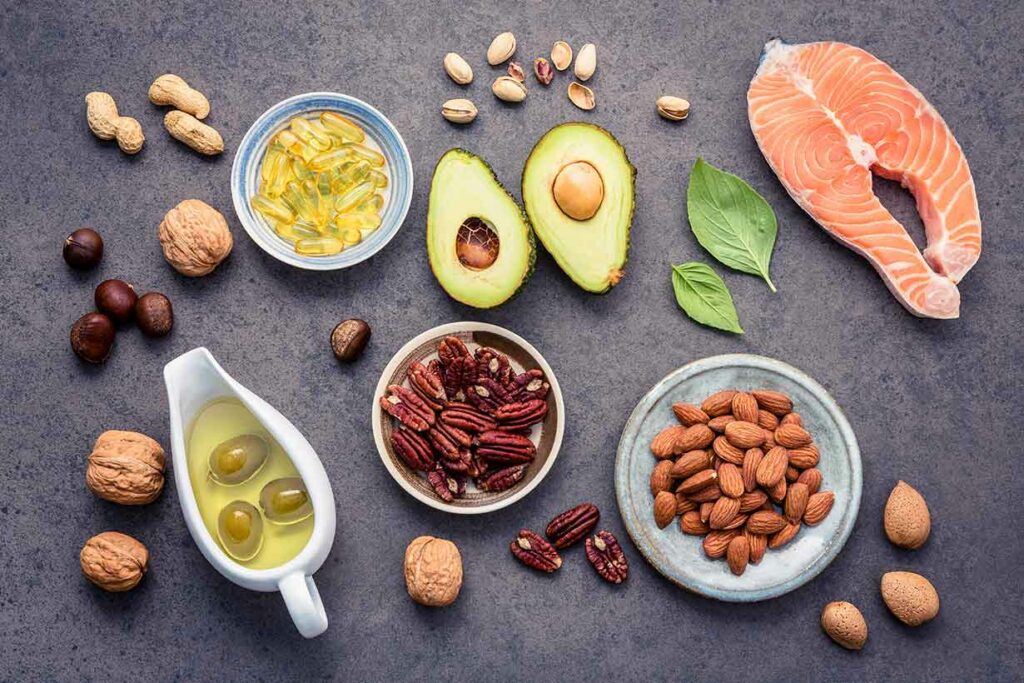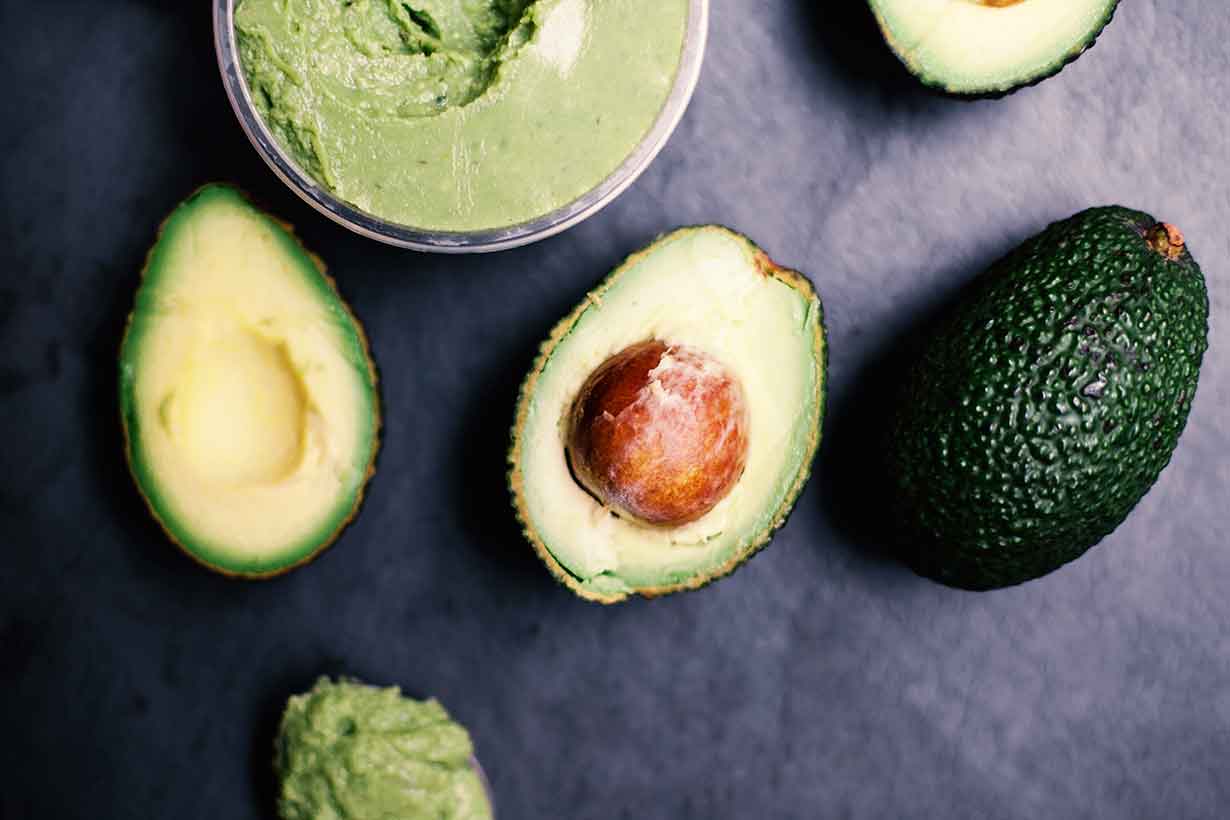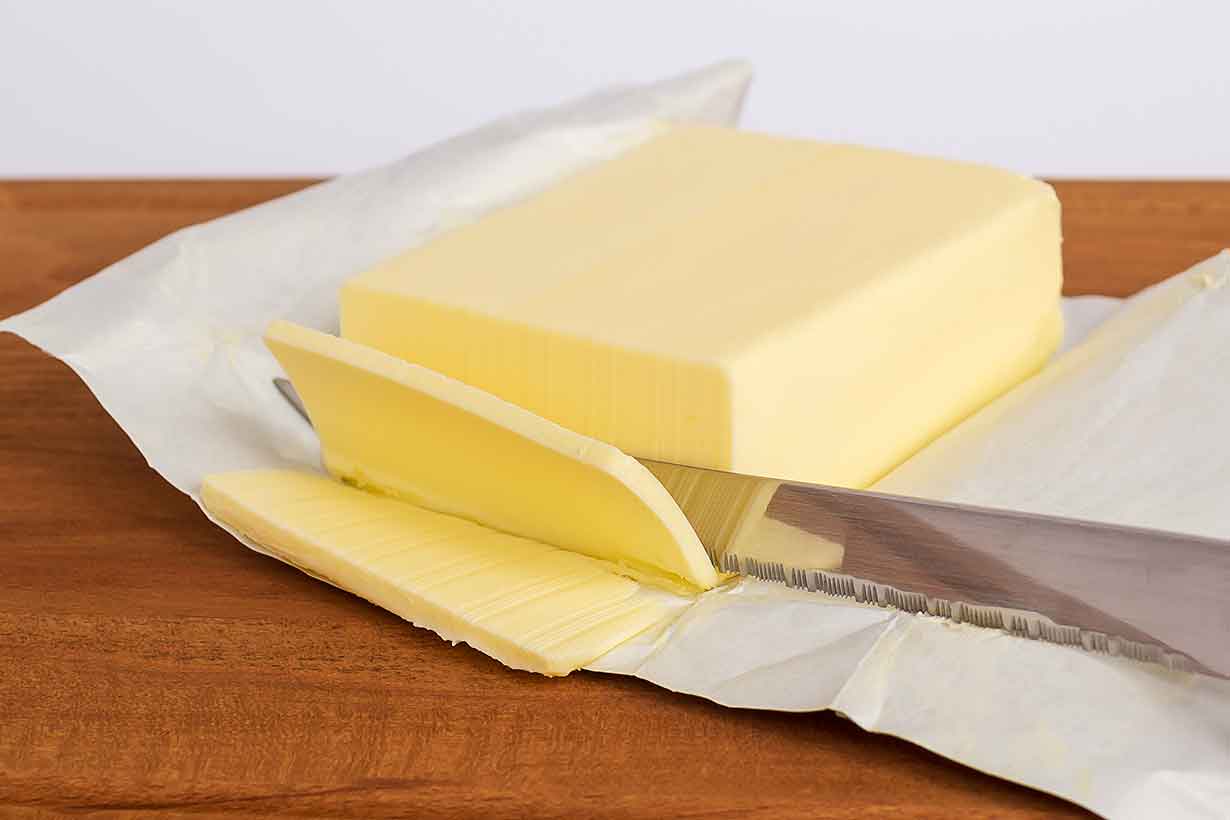The Fatty Acid Profiles of Common Foods
There are many different food sources of dietary fat.
Each of these foods contains different types of fatty acids, specifically saturated, monounsaturated, polyunsaturated, omega-3, and omega-6 fatty acids.
In this regard, some people may be trying to limit their intake of particular fatty acids or increase their intake of others.
However, it can be challenging to determine which foods contain which fatty acids.
This guide presents the fatty acid profile of common foods, organized by food category. Additionally, the most concentrated fatty acid for each food will be highlighted in bold.
All nutritional data is from the USDA FoodData Central Database and the NCC Nutrition Database.
Values are ‘per 100 grams‘ for each food.

Table of contents
- Fatty Acid Profiles of Cocoa Products (Per 100g)
- Fatty Acid Profiles of Cooking Oils and Fats (Per 100g)
- Fatty Acid Profiles of Dairy Foods (Per 100g)
- Fatty Acid Profiles of Eggs (Per 100g)
- Fatty Acid Profiles of Fruit and Vegetables (Per 100g Raw Weight)
- Fatty Acid Profiles of Grains (Per 100g Raw Weight)
- Fatty Acid Profiles of Legumes (Per 100g Raw Weight)
- Fatty Acid Profiles of Meat and Poultry (Per 100g Raw Weight)
- Fatty Acid Profiles of Nuts and Seeds (Per 100g)
- Fatty Acid Profiles of Seafood (Per 100g Raw Weight)
- Notes
Fatty Acid Profiles of Cocoa Products (Per 100g)
The following table shows the fatty acid profiles for chocolate products. Chocolate tends to contain mainly saturated fatty acids.Name Total Fat Saturated Monounsaturated Polyunsaturated Omega-3 Omega-6 Cocoa butter 100g 59.7g 32.9g 3.0g 0.10g 2.80g Cocoa powder 13.7g 8.07g 4.57g 0.44g 0.00g 0.44g Dark chocolate (70-85% cocoa) 42.63g 24.49g 12.78g 1.26g 0.03g 1.21g Milk chocolate 29.66g 18.51g 7.19g 1.38g 0.12g 0.31g White chocolate 32.09g 19.41g 9.10g 1.01g 0.10g 0.90g
Fatty Acid Profiles of Cooking Oils and Fats (Per 100g)
The fatty acid profiles of cooking oils tend to vary widely depending on the oil or fat source.
Most animal-based fats tend to be highest in saturated and monounsaturated fat. Meanwhile, a lot of vegetable oils are predominantly polyunsaturated fat.Name Total Fat Saturated Monounsaturated Polyunsaturated Omega-3 Omega-6 Avocado oil 100g 11.56g 70.55g 13.49g 0.96g 12.53g Butter 81.11g 50.49g 23.43g 3.01g 0.32g 1.01g Canola (rapeseed) oil 100.0g 7.37g 63.28g 28.14g 9.14g 18.64g Canola, high oleic 100.0g 6.79g 72.73g 15.79g 2.20g 12.92g Coconut oil 99.06g 82.48g 6.33g 1.70g 0.02g 1.70g Corn oil 100.0g 12.95g 27.58g 54.68g 1.16g 53.23g Cottonseed oil 100.0g 25.90g 17.80g 51.90g 0.20g 51.60g Ghee 99.48g 61.92g 28.73g 3.69g 1.45g 1.24g Goose fat 99.80g 27.70g 56.70g 11.0g 0.50g 9.80g Grapeseed oil 100.0g 9.60g 16.10g 69.90g 0.06g 69.60g Lard 100.0g 39.20g 45.10g 11.20g 1.00g 10.20g Macadamia oil 100.0g 14.31g 78.80g 2.52g 0.32g 2.21g Olive oil 100.0g 13.81g 72.96g 10.52g 0.76g 9.76g Palm kernel oil 100.0g 81.50g 11.40g 1.60g 0g 1.60g Peanut oil 100.0g 16.90g 46.20g 32.0g 0g 32.0g Rice bran oil 100.0g 19.70g 39.30g 35.0g 1.60g 33.40g Safflower oil 100.0g 6.20g 14.36g 74.62g 0g 74.62g Safflower oil, high oleic 100.0g 7.54g 75.22g 12.82g 0.10g 12.72g Sesame oil 100.0g 14.41g 39.70g 41.70g 0.30g 41.30g Soybean oil 100.0g 15.65g 22.78g 57.74g 6.79g 50.42g Sunflower oil 100.0g 10.30g 19.50g 65.70g 0g 65.70g Sunflower oil, high oleic 100.0g 9.86g 83.69g 3.80g 0.19g 3.61g Tallow (beef fat) 100.0g 49.80g 41.80g 4.00g 0.60g 3.10g Vegetable shortening (Crisco) 100.0g 25.0g 20.83g 50.0g 5.82g 43.44g
Fatty Acid Profiles of Dairy Foods (Per 100g)
Here are the fatty acid profiles for different dairy-based foods. Saturated fat tends to be the predominant fatty acid in dairy products.Name Total fat Saturated Monounsaturated Polyunsaturated Omega-3 Omega-6 Butter 81.11g 50.49g 23.43g 3.01g 0.32g 1.01g Buttermilk, whole 3.31g 1.90g 0.83g 0.20g 0.08g 0.10g Buttermilk, 2% fat 2.0g 1.24g 0.58g 0.07g 0.03g 0.03g Buttermilk, skim 0.88g 0.53g 0.25g 0.03g 0.01g 0.02g Cheese, Brie 27.68g 17.41g 8.01g 0.83g 0.31g 0.14g Cheese, Cheddar 33.31g 18.87g 8.27g 1.42g 0.14g 0.79g Cheese, Cheddar, 50% reduced-fat 15.76g 9.00g 4.08g 0.68g 0.07g 0.46g Cheese, Gouda 27.44g 17.61g 7.75g 0.66g 0.39g 0.26g Cheese, Mozzarella 24.64g 15.56g 7.03g 0.78g 0.21g 0.25g Cheese, Parmesan, fresh 25.0g 15.75g 7.52g 0.57g 0.30g 0.01g Cheese, Parmesan, dried, grated 27.84g 15.37g 7.13g 1.39g 0.12g 0.87g Cream cheese 28.60g 18.02g 8.07g 1.03g 0.38g 0.34g Cream cheese, light 16.67g 8.95g 4.00g 0.58g 0.08g 0.32g Milk, Whole 3.25g 1.87g 0.81g 0.20g 0.08g 0.07g Milk, 2% fat 1.96g 1.26g 0.56g 0.07g 0.01g 0.05g Milk, skim 0.08g 0.06g 0.02g <0.01g <0.01g <0.01g Sour cream 19.35g 10.14g 4.59g 0.80g 0.09g 0.44g Whey protein concentrate 10.24g 2.05g 1.30g 4.20g 0.47g 3.59g Yogurt, Greek 3.96g 2.48g 1.16g 0.11g 0.03g 0.05g Yogurt, Greek, low-fat 1.95g 1.22g 0.57g 0.06g 0.02g 0.03g Yogurt, whole 3.25g 2.10g 0.89g 0.09g 0.03g 0.02g Yogurt, low-fat 1.55g 1.00g 0.43g 0.04g 0.01g 0.03g
Fatty Acid Profiles of Eggs (Per 100g)
Several different egg varieties exist, and monounsaturated fats are generally the primary fatty acids in eggs.Name Total fat Saturated Monounsaturated Polyunsaturated Omega-3 Omega-6 Chicken egg 9.51g 3.13g 3.66g 1.91g 0.10g 1.58g Duck egg 13.77g 3.68g 6.53g 0.86g 0.07g 0.39g Goose egg 13.27g 3.60g 5.75g 1.67g 0.55g 0.68g Quail egg 11.09g 3.56g 4.32g 1.32g 0.04g 0.94g Turkey egg 11.88g 3.63g 4.57g 1.66g 0.08g 1.17g
Fatty Acid Profiles of Fruit and Vegetables (Per 100g Raw Weight)
Here are the fatty acid profiles for fruit and vegetables that contain at least a small amount of dietary fat.Name Total fat Saturated Monounsaturated Polyunsaturated Omega-3 Omega-6 Avocado 14.66g 2.13g 9.80g 1.82g 0.11g 1.69g Coconut 33.49g 29.70g 1.43g 0.37g 0.00g 0.37g Edamame (cooked) 6.40g 0.74g 1.21g 3.01g 0.35g 2.65g Fava beans 0.60g 0.14g 0.02g 0.31g 0.19g 0.12g Green peas 0.40g 0.07g 0.04g 0.19g 0.04g 0.0g Jackfruit 0.64g 0.20g 0.16g 0.09g 0.08g 0.02g Olives (green) 15.32g 2.03g 11.31g 1.31g 0.09g 1.22g Olives (black) 10.90g 2.28g 7.65g 0.63g 0.00g 0.63g Sweetcorn (canned and drained) 1.22g 0.25g 0.37g 0.52g 0.02g 0.14g
Fatty Acid Profiles of Grains (Per 100g Raw Weight)
Although they are predominantly a source of carbohydrates, grains do contain small amounts of fat.
Here are the fatty acid profiles for some of the most common whole-grain varieties.Name Total fat Saturated Monounsaturated Polyunsaturated Omega-3 Omega-6 Amaranth 7.02g 1.46g 1.69g 2.78g 0.04g 2.74g Brown rice 2.68g 0.54g 0.97g 0.96g 0.04g 0.92g Buckwheat 3.40g 0.74g 1.04g 1.04g 0.08g 0.96g Millet 4.22g 0.72g 0.77g 2.13g 0.12g 2.02g Oats 6.52g 1.11g 1.98g 2.30g 0.10g 2.20g Quinoa 6.07g 0.71g 1.61g 3.29g 0.31g 2.98g Sorghum 3.46g 0.61g 1.13g 1.56g 0.07g 1.49g Teff 4.59g 0.87g 1.14g 2.07g 0.26g 1.81g Whole wheat flour 2.50g 0.43g 0.28g 1.17g 0.07g 1.09g Wild rice 1.08g 0.16g 0.16g 0.68g 0.30g 0.38g
Fatty Acid Profiles of Legumes (Per 100g Raw Weight)
Most legumes contain at least a small amount of dietary fat. However, some legumes, such as lupin beans and soybeans, provide substantial amounts of fat.
Here are the fatty acid profiles of some common legumes.Name Total fat Saturated Monounsaturated Polyunsaturated Omega-3 Omega-6 Black beans 1.42g 0.37g 0.12g 0.61g 0.28g 0.33g Black-eyed peas 1.26g 0.33g 0.11g 0.54g 0.20g 0.34g Lentils 1.06g 0.15g 0.19g 0.53g 0.11g 0.41g Lima beans 0.69g 0.16g 0.06g 0.31g 0.10g 0.22g Lupin beans 9.74g 1.16g 3.94g 2.44g 0.45g 2.00g Mung beans 1.15g 0.35g 0.16g 0.38g 0.03g 0.36g Navy beans 1.50g 0.17g 0.13g 0.87g 0.54g 0.34g Pinto beans 1.23g 0.24g 0.23g 0.41g 0.24g 0.17g Soybeans 19.94g 2.88g 4.40g 11.26g 1.33g 9.93g Split peas 0.68g 0.12g 0.06g 0.33g 0.06g 0.00g
Fatty Acid Profiles of Meat and Poultry (Per 100g Raw Weight)
The primary fatty acids in meat and poultry tend to be saturated and monounsaturated fats.
However, the fat content can significantly vary depending on how the animal was fed, and whether the meat is a lean or fatty cut.Name Total fat Saturated Monounsaturated Polyunsaturated Omega-3 Omega-6 Beef, ground, 80% lean 20.0g 7.58g 8.85g 0.52g 0.05g 0.44g Beef, ground, 95% lean 5.00g 2.18g 1.99g 0.26g 0.03g 0.19g Beef kidney 4.65g 1.44g 0.96g 1.14g 0.01g 1.08g Beef liver 5.26g 2.95g 1.12g 1.11g 0.02g 1.08g Bison, ground 15.93g 6.80g 6.22g 0.75g 0.08g 0.58g Chicken breast, skinless 4.51g 1.27g 1.54g 0.98g 0.10g 0.82g Chicken breast, skin 7.42g 2.08g 2.90g 1.58g 0.10g 1.41g Chicken drumstick 9.95g 2.93g 3.59g 2.87g 0.17g 2.60g Chicken thigh 16.61g 4.52g 6.94g 3.47g 0.17g 3.12g Duck, meat and skin, domestic 39.34g 13.22g 18.69g 5.08g 0.39g 4.69g Duck, skinless, domestic 5.95g 2.32g 1.54g 0.75g 0.08g 0.67g Duck, meat and skin, wild 12.10g 3.91g 5.63g 1.19g 0.01g 1.06g Duck, skinless, wild 4.25g 1.32g 1.21g 0.58g 0.07g 0.51g Goose, meat and skin, domestic 33.62g 9.78g 17.77g 3.76g 0.21g 3.34g Goose meat, skinless, domestic 7.13g 2.79g 1.85g 0.90g 0.10g 0.80g Lamb, loin chop 26.19g 11.16g 7.47g 0.97g 0.31g 0.27g Lamb, ground, 85% lean 20.71g 9.93g 7.95g 1.12g 0.32g 0.42g Pork belly 53.01g 19.33g 24.70g 5.65g 0.48g 5.03g Pork chop, loin 15.15g 5.35g 6.68g 1.30g 0.01g 1.17g Pork, ground, 84% lean 16.0g 4.93g 6.68g 2.05g 0.12g 1.90g Pork, ground, 96% lean 4.0g 1.42g 1.89g 0.66g 0.04g 0.56g Turkey breast, with skin 7.42g 2.08g 2.90g 1.58g 0.10g 1.41g Turkey breast, skinless 2.08g 0.59g 0.63g 0.53g 0.03g 0.47g Turkey, ground, 85% lean 12.54g 3.41g 4.55g 3.49g 0.20g 3.09g Turkey, ground, 93% lean 8.34g 2.17g 2.84g 2.54g 0.15g 2.22g
Fatty Acid Profiles of Nuts and Seeds (Per 100g)
With the exception of chestnuts, most nuts and seeds have a high fat content.
Depending on the type of nut or seed, either monounsaturated or polyunsaturated fatty acids are the main fatty acids.Name Total fat Saturated Monounsaturated Polyunsaturated Omega-3 Omega-6 Acorns 23.86g 3.10g 15.11g 4.60g – 4.60g Almonds 49.93g 3.80g 31.55g 12.33g 0.01g 12.32g Brazil nuts 67.10g 16.13g 23.88g 24.40g 0.02g 23.88g Cashew nuts 43.85g 7.78g 23.80g 7.85g 0.06g 7.78g Chestnuts 3.91g 0.74g 1.35g 1.55g 0.17g 1.38g Chia seeds 30.74g 3.78g 2.31g 23.67g 17.83g 5.84g Flax seeds 42.16g 3.66g 7.53g 28.73g 22.81g 5.90g Hemp seeds 35.50g 2.94g 3.83g 24.50g 7.08g 17.35g Hickory nuts 64.37g 7.04g 32.61g 21.89g 1.05g 20.62g Macadamia nuts 75.77g 12.06g 58.88g 1.50g 0.21g 1.30g Peanuts 49.24g 6.28g 24.43g 15.56g 0.01g 15.52g Pecans 71.97g 6.18g 40.80g 21.61g 0.99g 20.63g Pili nuts 68.37g 4.90g 18.76g 34.07g 0.11g 33.61g Pistachio nuts 45.32g 5.91g 23.26g 14.38g 0.29g 14.09g Poppy seeds 41.56g 4.52g 5.98g 28.57g 0.27g 28.29g Pumpkin seeds 49.05g 8.54g 15.73g 19.86g 0.11g 19.56g Sesame seeds 49.67g 6.96g 18.76g 21.77g 0.38g 21.37g Sunflower seeds 51.46g 4.46g 18.53g 23.14g 0.09g 23.05g Walnuts 65.21g 6.13g 8.93g 47.17g 9.08g 38.09g Watermelon seeds 47.37g 9.78g 7.41g 28.09g 0.00g 28.09g
Fatty Acid Profiles of Seafood (Per 100g Raw Weight)
Seafood can be quite lean or fatty, depending on the specific type of fish. Additionally, fatty seafood provides the best dietary source of omega-3 fatty acids.
Here are the fatty acid profiles for various common seafood options.Name Total fat Saturated Monounsaturated Polyunsaturated Omega-3 Omega-6 Abalone 0.76g 0.15g 0.11g 0.10g 0.09g 0.01g Anchovies 4.84g 1.28g 1.18g 1.64g 1.48g 0.10g Catfish (farmed) 7.19g 1.59g 3.12g 1.35g 0.17g 1.01g Catfish (wild) 2.85g 0.74g 1.10g 0.64g 0.42g 0.20g Clams 0.96g 0.12g 0.12g 0.19g 0.13g 0.04g Conch (cooked) 1.20g 0.37g 0.33g 0.27g 0.12g 0.05g Crab 1.08g 0.22g 0.19g 0.39g 0.32g 0.01g Crayfish 1.20g 0.18g 0.24g 0.37g 0.20g 0.15g Eel 11.66g 2.36g 7.19g 0.95g 0.65g 0.20g Fish roe 6.42g 1.46g 1.66g 2.66g 2.43g 0.03g Herring 9.04g 2.04g 3.74g 2.13g 1.73g 0.13g Lobster 0.75g 0.18g 0.22g 0.30g 0.22g 0.04g Mackerel 13.89g 3.26g 5.46g 3.35g 2.67g 0.22g Mussels 2.24g 0.43g 0.51g 0.61g 0.52g 0.08g Octopus 1.04g 0.23g 0.16g 0.24g 0.16g 0.01g Oysters 2.30g 0.51g 0.36g 0.89g 0.82g 0.06g Sablefish 15.30g 3.20g 8.06g 2.04g 1.66g 0.17g Salmon (Atlantic, farmed) 13.42g 3.05g 3.77g 3.89g 2.51g 0.98g Salmon (Atlantic, wild) 6.34g 0.98g 2.10g 2.54g 2.02g 0.17g Sardines 10.40g 3.00g 2.90g 3.10g 2.60g 0.20g Shrimp 0.51g 0.10g 0.09g 0.15g 0.07g 0.04g Sprats 6.53g 1.47g 2.70g 1.54g 1.38g 0.16g Squid 1.38g 0.36g 0.11g 0.52g 0.50g 0.01g Striped bass 2.33g 0.51g 0.66g 0.78g 0.77g 0.02g Swordfish 6.65g 1.61g 3.00g 1.15g 0.94g 0.07g Tuna (light, canned in water) 0.96g 0.21g 0.11g 0.28g 0.23g 0.02g Tuna (white, canned in water) 2.97g 0.79g 0.78g 1.11g 0.95g 0.06g Tuna, bluefin 4.90g 1.26g 1.60g 1.43g 1.30g 0.05g Tuna, skipjack 1.01g 0.33g 0.19g 0.32g 0.27g 0.02g Tuna, yellowfin 0.49g 0.17g 0.12g 0.15g 0.11g 0.01g
Notes
- All nutritional values are courtesy of the USDA FoodData Central Database and NCC Nutrition Database. These are the two of the most reliable major nutrition databases.
- Plant foods can vary depending on the growing conditions. Additionally, animal-based foods can vary nutritionally depending on how the animals were fed, and how lean the food is. In other words: although the values should be very accurate, food can vary slightly from one sample to another.
- Knowing the fatty acid profile of a particular food can be very useful. However, dietary decisions should be based on all the nutrients a food offers, as well as the overall diet.




